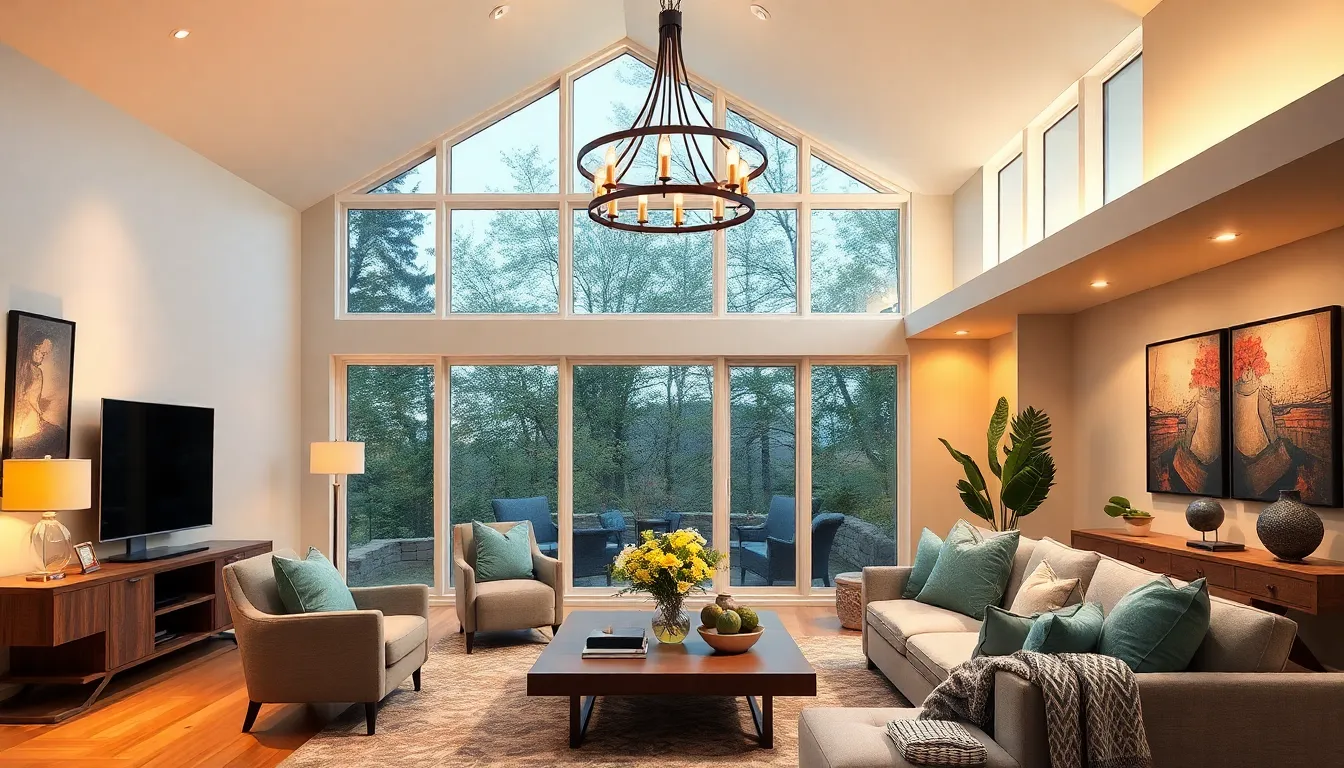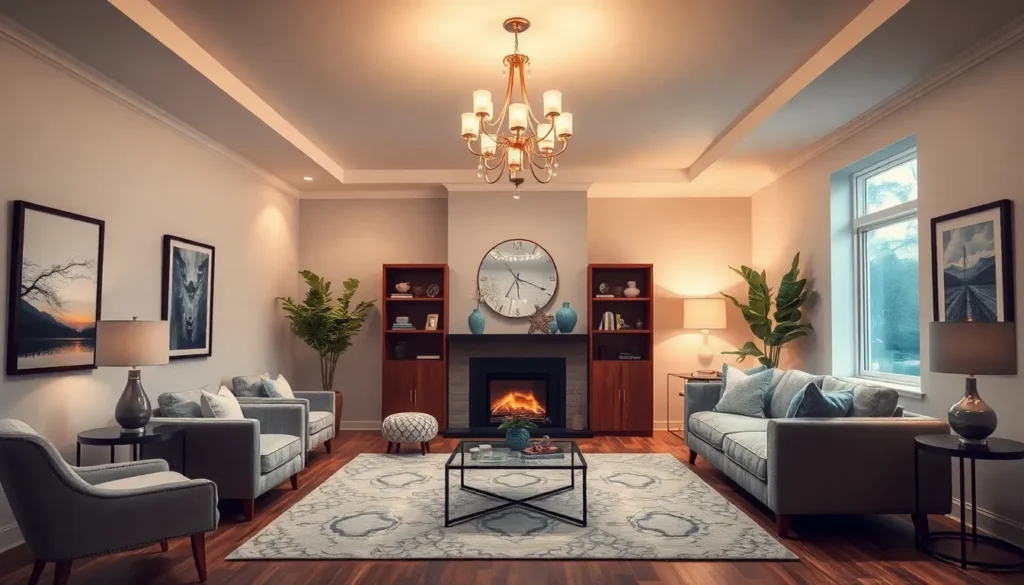When it comes to home lighting design, most people think it’s just about flipping switches and illuminating dark corners. But let’s face it—lighting is the unsung hero of interior design. It sets the mood, highlights your favorite art piece, and can even make that questionable wallpaper look somewhat decent. Who knew that the right light could transform a cozy nook into a romantic getaway or a home office into a productivity powerhouse?
Home Lighting Design
Home lighting design encompasses more than just placement of fixtures. It shapes the atmosphere and functionality of living spaces.
Importance of Lighting in Home Design
Lighting influences mood throughout a home. Proper illumination can highlight artwork, create warmth, or promote focus in spaces like offices. It can alter perceptions of size and color in rooms. Layers of light enhance both visual interest and density within environments. Effective lighting directs attention, inviting occupants to engage more deeply with their surroundings.
Key Elements of Home Lighting
Key elements include ambient, task, and accent lighting. Ambient lighting serves as the primary light source, functionally illuminating the entire room. Task lighting focuses on specific areas, such as desks or kitchen counters, ensuring functionality. Accent lighting draws the eye to particular features, like architectural details or artwork. Consideration of light temperature, placement, and fixture styles also plays a crucial role in achieving balance. Selecting the right combination results in a cohesive and appealing design.
Types of Home Lighting Design

Home lighting design features three primary types: ambient, task, and accent lighting. Each type serves a unique purpose, contributing to the overall functionality and ambiance of a space.
Ambient Lighting
Ambient lighting provides the main source of illumination in a home. Soft ceiling fixtures like chandeliers or recessed lights create a comfortable atmosphere. It’s essential for visibility and can set the mood throughout the entire room. Designers often choose warm light temperatures to promote relaxation. Effective placement of ambient lighting promotes even light distribution, minimizing shadows.
Task Lighting
Task lighting focuses on specific areas to enhance functionality. This type of lighting is vital in spaces like kitchens, offices, or reading nooks. Desk lamps and under-cabinet lights qualify as excellent examples of task lighting. Properly positioned fixtures help ensure safety and efficiency when completing tasks. Bright, focused light also reduces eye strain, making work more comfortable.
Accent Lighting
Accent lighting highlights particular features within a room, such as artwork or architectural details. Spotlights and wall-mounted fixtures provide focused illumination to create visual interest. This type helps add depth and dimension to spaces, drawing attention to design elements. Using dimmable options offers flexibility in creating various moods. Strategic placement amplifies the beauty and uniqueness of a home.
Tips for Effective Home Lighting Design
Effective home lighting design involves thoughtful planning and execution. It influences the functionality and ambiance of each space.
Choosing the Right Fixtures
Selecting the right fixtures matters in home lighting design. Consider the style of each room when choosing fixtures like chandeliers, pendant lights or recessed lighting. Opt for functional designs in task-heavy areas, such as kitchens or home offices, where desk lamps and under-cabinet lights play crucial roles. Accent fixtures, like wall sconces or spotlights, draw focus to artwork or architectural elements. Match the fixture sizes to the scale of the room for balance, ensuring each piece complements the overall aesthetic.
Layering Light
Layering light creates depth and versatility in spaces. Start with ambient light for overall illumination, then add task lighting to enhance functionality in work areas. Utilize accent lighting to highlight features and add character to rooms. Combining layers allows for control over brightness and mood. The use of dimmers helps adjust intensity seamlessly, providing options for different occasions. Maintain harmony by considering the placement of each light source, ensuring they work together to enhance the room’s character and usability.
Using Color Temperature
Using color temperature effectively shapes the mood of a space. Warm tones, around 2700K to 3000K, create a cozy feel, perfect for living rooms and bedrooms. Cool tones, between 4000K to 5000K, promote alertness, making them ideal for home offices and kitchens. Choosing a consistent temperature throughout spaces maintains coherence and enhances design flow. Mixing temperatures can lead to discord, so select light bulbs that align with the desired atmosphere. Experiment with different settings to discover the perfect combination that enhances each area’s purpose.
Common Mistakes in Home Lighting Design
Home lighting design often encounters pitfalls that impact aesthetics and function. Understanding these mistakes fosters better planning and execution.
Overlooking Natural Light
Natural light significantly contributes to a home’s ambiance. Many designs neglect this vital element, leading to artificial lighting that feels harsh or inadequate. Positioning mirrors to reflect daylight can enhance brightness during the day. Window treatments that filter light instead of blocking it will also optimize the natural glow in each room. Consider arranging furnishings to capitalize on sunlight, allowing deeper integration of natural illumination.
Ignoring Functionality
Functionality remains a fundamental aspect of lighting design. Failing to assess how each space is used can result in inadequate lighting solutions. Task lighting serves specific purposes, such as reading or cooking, so it’s crucial to include focused fixtures in those areas. Ensuring adequate illumination in high-traffic zones, like hallways and staircases, enhances safety. Prioritizing light placement alongside room activity creates a more efficient and inviting environment.
Conclusion
Effective home lighting design is essential for creating inviting and functional spaces. By understanding the interplay of ambient, task, and accent lighting, homeowners can elevate their interiors and enhance the overall atmosphere. Thoughtful planning and execution can transform a room’s character while ensuring it meets the needs of its occupants.
Incorporating natural light and using the right fixtures can further enhance the aesthetic appeal. By avoiding common pitfalls and prioritizing light placement, individuals can cultivate environments that are both beautiful and practical. Ultimately, the right lighting design not only improves the look of a home but also enriches the daily experiences of those who live there.


More Stories
Home Trends and Design: Transform Your Space with the Latest Stylish Innovations
Custom Home Design Services: Transform Your Dream Home into Reality Today
Studio41 Home Design Showroom: Transform Your Space with Exceptional Design Inspiration